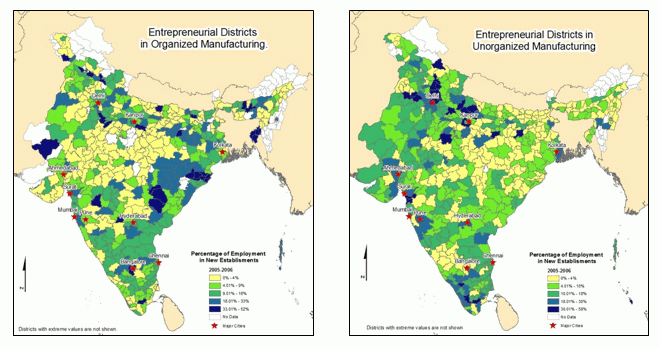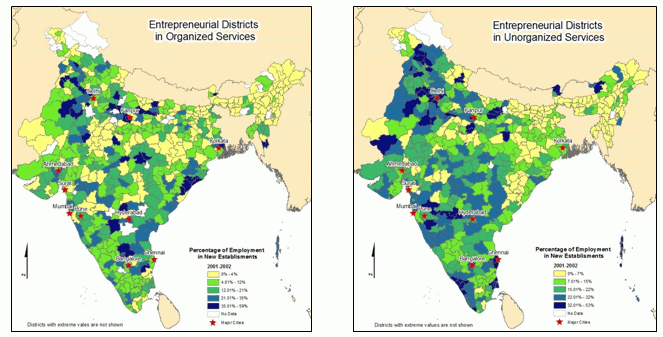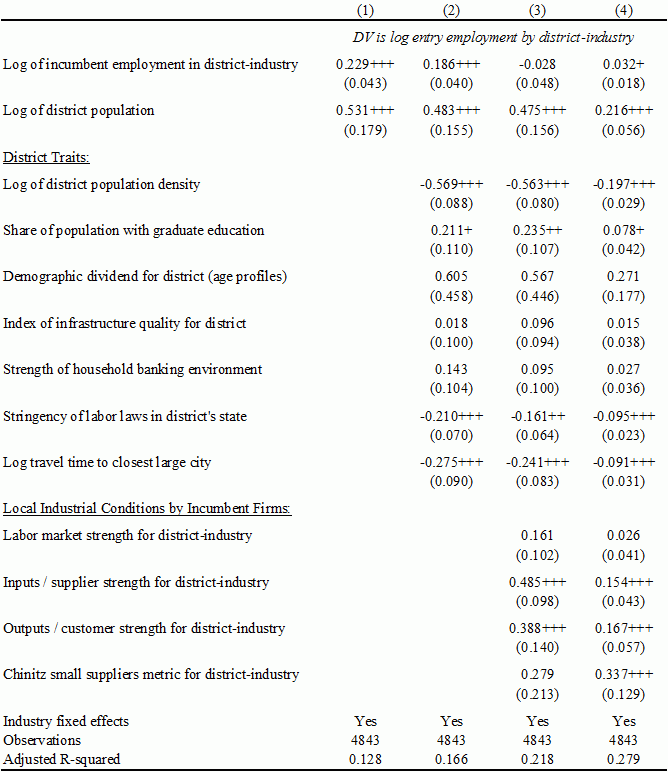Policymakers in both developed and developing countries want to encourage entrepreneurship to boost economic growth and job creation. Multiple studies have examined this question in advanced economies (Alcacer and Chung 2010, Dauth 2011, Delgado et al 2010, Drucker and Feser 2007, Duranton and Overman 2008, Glaeser and Kerr 2009, Rosenthal and Strange 2010, Jofre-Monseny et al forthcoming). However, similar work for developing countries is still at an early stage. Why do some cities in developing countries attract more entrepreneurs and become engines of growth? Others do not?
Facts
In recent research, we examine the spatial location of entrepreneurs in India in manufacturing and services sectors, as well as in the formal and informal sectors (Ghani et al 2011a and 2011b). We use cross-sectional establishment-level surveys, carried out by the Indian government over the last two decades in 630 districts spread across 35 states/union territories. We quantify entrepreneurship as young firms that are less than three years old, and define entry measures through employment in these new establishments.
Figures 1 and 2 present the entrepreneurship rates at the district level in manufacturing and services sectors in both organised and unorganised sectors. There is a great deal of spatial variation in entry rates in India. What explains this?
Figure 1. Indian manufacturing entry rates
Figure 2. Indian services entry rates
We examine the role of demographic traits (age profiles, population, population density), structural traits (education of the local labour force, quality of local physical infrastructure, travel time to major cities, stringency of labour laws, and household banking conditions), and agglomeration economies. While these traits do not constitute an exhaustive list of local conditions, they are motivated by the literature on India’s development.
We develop metrics that unite the incumbent industrial structures of districts with the extent to which industries interact through the traditional agglomeration channels (Marshall 1920). The first agglomeration channel is proximity to customers and suppliers, which reduces transportation costs and thereby increases productivity. The second is the Chinitz effect. Chinitz (1961) argued that the large, integrated steel firms of Pittsburgh depressed external supplier development. By contrast, New York City's much smaller firms, organised around the decentralised garment industry that then dominated the city, were better suppliers to new firms. The third channel is labour pooling. While a district’s education and basic demographics are informative about the suitability of the local labour force, these aggregate traits can miss the very specialised nature of many occupations. These specialised workers are often tightly clustered together (Rosenthal and Strange 2010).
Analysis
Table 1 provides the basic spatial results for the organised manufacturing sector. The first column includes just district populations, district-industry employments, and industry fixed effects. Not surprisingly, existing district-industry employment strongly shapes the spatial location of entry: a 10% increase in incumbent employment raises entry employment by around 2%. In addition, a district’s population increases entry rates with an elasticity of 0.5.
Table 1. District entrepreneurship estimations – Organised manufacturing
Notes: Estimations quantify the relationship between district-industry employment in new establishments and local conditions. District-level traits are taken from the 2001 Census. Industrial conditions are calculated from 2005-06 using incumbent establishments in the district-industry. Labor regulations are a composite of adjustment and disputes laws. Estimations weight observations by an interaction of district size and industry size, include industry fixed effects, and cluster standard errors by district. Non-logarithm variables are transformed to have unit standard deviation for interpretation.
Column 2 includes the district traits. Three factors stand out as discouraging entrepreneurship in organised manufacturing: high population density, strict labour regulations, and greater distance to one of India’s ten biggest cities. The first pattern has been observed in many settings, and is closely studied by Desmet et al (2011) in India. The traded nature of manufacturing products allows more rural settings for firms, and manufacturers often seek cheaper environments than the wages and rents associated with high-density areas. The second pattern connects with the earlier studies of India that argue strict labour laws reduce economic growth. Entrepreneurship in labour-intensive industries is disproportionately reduced by strict labour laws. The final factor highlights that while manufacturers avoid the high costs of urban areas, they also avoid the most remote areas of India in favour of settings that are relatively near large population centres, likely to access customers directly or to connect to shipping routes. The education of a district’s workforce is strongly linked to higher entry rates. The elasticity is in fact stronger in economic magnitude than that evident in comparable studies of advanced economies.
The third column introduces the district-industry traits. The qualities of input and output markets are exceptionally strong with 0.4–0.5 elasticities. Labour market and the Chinitz measure have positive coefficients. The decline in the main effect of incumbent employment suggests that these four new metrics capture the positive channels of agglomeration on entry.
Table 2 repeats these estimations for the unorganised manufacturing sector. Several distinct differences exist. First, local population takes a much greater role with unit elasticity in Column 1’s simplest estimation. This greater connection of entry to the overall size of local markets almost certainly reflects unorganised entry being proportionate to market size and servicing local needs. Unorganised manufacturing clearly conforms much more closely to the overall contours of India’s economic geography than organised manufacturing.
Table 2. District entrepreneurship estimations – Unorganised manufacturing
Notes: See Table 1.
The other two district traits that are associated with strong entry rates are the strength of local, within-district physical infrastructure and the strength of local household banking environments. This contrasts with organised manufacturing entry, where education stood out. An intuitive explanation, which is also reflected in the services estimations, is that these patterns and their differences reflect the factors on which each sector depends most. Organised manufacturing establishments, for example, may have broader resources that reduce dependency on local infrastructure and household finance. Likewise, the unorganised sector depends less on educated workers than the organised sector.
Table 3 presents comparable estimations for the services sector, with Columns 1–3 for the organised sector and Columns 4–6 for the unorganised sector. The patterns and their contrast to organised manufacturing are again quite intriguing. First, overall district population is as important as it was for unorganised manufacturing, with its elasticity greater than one. Similar also to unorganised manufacturing, population density and travel time to major cities are not important in the multivariate setting, while the district’s age profile does contribute to higher entry levels.
Table 3. District entrepreneurship estimations – Services
Among district traits, education and infrastructure matter the most. Overall, education is found to be generally important, with particular relevance to the organised sectors of manufacturing and services. Physical infrastructure is also important, with particular relevance to the unorganised sectors of the economy. The strength of the household banking sector is also very important in the unorganised sectors of the economy.
Agglomeration economies operate as strongly for entrants in India as they do in advanced economies. Most strikingly, the importance of the Chinitz effect is concentrated among small entrants. It matters more in materially intensive industries. The importance of overall output markets and labour spillovers grow with entrant size. It appears that input cost factors are more influential in the location choices of small start-ups in India, while output conditions and labour markets are more important for large entrants.
Conclusions
India’s economic geography is still taking shape. A comparison of India with the US shows that the existing city population levels, city-industry employment, and industry fixed effects can explain 80% of the spatial variation in the US’s entry rates. The comparable explanatory power for India is just 29% for manufacturing and 33% for services. A large portion of this gap is due to India being at a much earlier stage of development. The industrial landscape is also adjusting after the deregulations of the 1980s and 1990s. At such an early point and with industrial structures not yet entrenched, local policies and traits can have profound and lasting impacts by shaping where industries plant their roots.
Agglomeration economies are very important for India’s entry patterns. We find strong evidence of agglomeration economies in India’s manufacturing sector. In a similar manner, we find extensive evidence that the incumbent compositions of local industries influence new entry rates at the district-industry level within manufacturing. This influence is through both traditional Marshallian economies like a suitable labour force and proximity to customers and through the Chinitz effect that emphasises small suppliers.
Education and physical infrastructure matter greatly. The two most consistent factors that predict overall entrepreneurship for a district are its education and the quality of local physical infrastructure. These patterns are true for manufacturing and services. These relationships are much stronger in India than those found for the United States. Higher education in a local area increases the supply of entrepreneurs and increases the talent available to entrepreneurs for staffing their companies. Investment in people is an easy call for policymakers. Likewise, local areas must improve their infrastructure – electricity, roads, telecoms, and water/sanitation facilities.
Disclaimer: The views expressed here are those of the authors and not necessarily of the World Bank or any other institution.
References
Alcacer, Juan, and Wilburg Chung (2010), “Location Strategies for Agglomeration Economies”, HBS Working Paper.
Chinitz, Benjamin (1961), “Contrasts in Agglomeration: New York and Pittsburgh”, American Economic Review, 51(2): 279–289.
Dauth, Wolfgang (2011), “The Mysteries of the Trade: Interindustry Spillovers in Cities”, Working Paper.
Delgado, Mercedes, Michael Porter, and Scott Stern (2010), “Clusters and Entrepreneurship”, Journal of Economic Geography, 10(4): 495–518.
Desmet, Klaus, Ejaz Ghani, Stephen O’Connell, and Esteban Rossi-Hansberg (2011), “The Spatial Development of India”, mimeo, City University of New York.
Drucker, Joshua, and Edward Feser (2007), “Regional Industrial Dominance, Agglomeration Economies, and Manufacturing Plant Productivity”, CES Working Paper 07-31.
Duranton, Gilles, and Henry Overman (2008), “Exploring the Detailed Location Patterns of UK Manufacturing Industries Using Microgeographic Data”, Journal of Regional Science, 48(1):313-343.
Ghani, Ejaz, William Kerr, and Stephen O'Connell (2011a), “Promoting Entrepreneurship, Growth, and Job Creation”, in Ejaz Ghani (ed), Reshaping Tomorrow, Oxford: Oxford University Press.
Ghani, Ejaz, William Kerr, and Stephen O'Connell (2011b), “Spatial Determinants of Entrepreneurship in India”, NBER Working Paper 17514.
Glaeser, Edward, and William Kerr (2009), “Local Industrial Conditions and Entrepreneurship: How Much of the Spatial Distribution Can We Explain?”, Journal of Economics and Management Strategy, 18(3): 623–63.
Jofre-Monseny, Jordi, Raquel Marín-López, and Elisabet Viladecans-Marsal (forthcoming), “The Mechanisms of Agglomeration: Evidence from the Effect of Inter-Industry Relations on the Location of New Firms”, Journal of Urban Economics.
Marshall, Alfred (1920), Principles of Economics, London: MacMillan and Co.
Rosenthal, Stuart, and William Strange (2010), “Small Establishments/Big Effects: Agglomeration, Industrial Organization and Entrepreneurship”, in Glaeser, Edward (ed) Agglomeration Economics, Chicago: University of Chicago Press.











